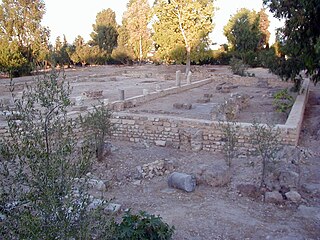
Pope Miltiades, also known as Melchiades the African, was the bishop of Rome from 311 to his death on 10 or 11 January 314. It was during his pontificate that Emperor Constantine the Great issued the Edict of Milan (313), giving Christianity legal status within the Roman Empire. The pope also received the palace of Empress Fausta where the Lateran Palace, the papal seat and residence of the papal administration, would be built. At the Lateran Council, during the schism with the Church of Carthage, Miltiades condemned the rebaptism of apostatised bishops and priests, a teaching of Donatus Magnus.

Donatism was a Christian sect leading to a schism in the Church, in the region of the Church of Carthage, from the fourth to the sixth centuries. Donatists argued that Christian clergy must be faultless for their ministry to be effective and their prayers and sacraments to be valid. Donatism had its roots in the long-established Christian community of the Roman province Africa Proconsularis and Mauretania Tingitana, in the persecutions of Christians under Diocletian. Named after the Berber Christian bishop Donatus Magnus, Donatism flourished during the fourth and fifth centuries. Donatism mainly spread among the indigenous Berber population, and Donatists were able to blend Christianity with many of the Berber local customs.
The Circumcellions or Agonistici were bands of Roman Christian radicals in North Africa in the early to mid-4th century. They were considered heretical by the Catholic Church. They were initially concerned with remedying social grievances, but they became linked with the Donatist sect. They condemned poverty and slavery, and advocated canceling debt and freeing slaves.

Donatus Magnus, also known as Donatus of Casae Nigrae, was the leader of a schismatic Christian sect known as the Donatists in North Africa, Algeria. He is believed to have died in exile around 355.

Optatus, sometimes anglicized as Optate, was Bishop of Milevis, in Numidia, in the fourth century, remembered for his writings against Donatism.
Caecilianus, or Caecilian, was archdeacon and then bishop of Carthage in 311 AD. His appointment as Bishop led to the Donatist Controversy of the Late Roman Empire. He was also one of only five Western bishops at the First Council of Nicea.

The Archdiocese of Carthage, also known as the Church of Carthage, was a Latin Catholic diocese established in Carthage, Roman Empire, in the 2nd century. Agrippin was the first named bishop, around 230 AD. The temporal importance of the city of Carthage in the Roman Empire had previously been restored by Julius Caesar and Augustus. When Christianity became firmly established around the Roman province of Africa Proconsulare, Carthage became its natural ecclesiastical seat. Carthage subsequently exercised informal primacy as an archdiocese, being the most important center of Christianity in the whole of Roman Africa, corresponding to most of today's Mediterranean coast and inland of Northern Africa. As such, it enjoyed honorary title of patriarch as well as primate of Africa: Pope Leo I confirmed the primacy of the bishop of Carthage in 446: "Indeed, after the Roman Bishop, the leading Bishop and metropolitan for all Africa is the Bishop of Carthage."
Secundus of Tigisis was an early church leader and primate of Numidia. He was a leading organiser of the early Donatist movement in Carthage.

Sétifis, was a Roman town located in northeastern Algeria. It was the capital of the Roman province called Mauretania Sitifensis, and it is today Setif in the Sétif Province (Algeria).

Majorinus was the leader of a schismatic Christian sect in Roman North Africa known as the Donatists.
Maximian was a 4th-century Bishop of Carthage and founder of a splinter group that left Donatism.
Maximian of Bagai was a 5th century bishop of Bagai in Roman North Africa. His life shows the extent that the religious schism in Roman North Africa could become violent.
Optatus of Thamugadi was, from 388 to 398, a donatist bishop in the city of Thamugadi (Timgad) in the Roman province of Numidia. He was an important subject in the anti-donatistic polemic of Augustine, who was at that time a bishop in Hippo Regius and who called him evil.
Vageata, also known as Vageatensis, was a Roman-Berber town in the province of Mauretania Caesariensis. It is also known as Bagatensis, and epigraphical evidence remains attesting to this etymology, due to the interchange of 'v' for 'b' is a common phenomenon in Latin and Greek place names.
Ksar-El-Kelb is an archaeological site in Tebessa, Algeria. It existed in the Roman province of Numidia and is highly believed to be the location of the Ancient city and former bishopric of Vegesela in Numidia, which remains a Latin Catholic titular see.
The Rogatists were a religious movement within early Christianity that separated in the 4th century from the Donatists over the use of violence in the church. Much of what we know about the Rogatists comes from the writings of Augustine, against both them and the Donatists.

Bagai was a Roman–Berber city in the province of Africa Proconsularis. It must have been of some reasonable size, as it was also the seat of an ancient Catholic bishopric. The ancient city has been identified with ruins at Ksar-Bagaï outside of Baghai, in the Aurès Mountains of the El Hamma District in Khenchela Province, Algeria.
Parmenian was a North African Donatist bishop, the successor of Donatus in the Donatist bishopric of Carthage. He wrote several works defending the rigorist views of the Donatists and is recognized as "the most famous Donatist writer of his day", but none of his writings have survived.
Donatus of Bagaï, also known as Donatus of Aurasium, was an ancient Donatist bishop and martyr whose life and actions played a significant role in the complex religious landscape of 4th century Numidia. Despite being primarily known through hostile reports, notably found in Optatus' "Contra Parmenianum Donatistam" Donatus of Bagai left a lasting impact on the Donatist movement.

Marculus of Thamugadi or simply Marculus was a prominent bishop and Christian martyr venerated by the 4th-century North African Donatist Church.









